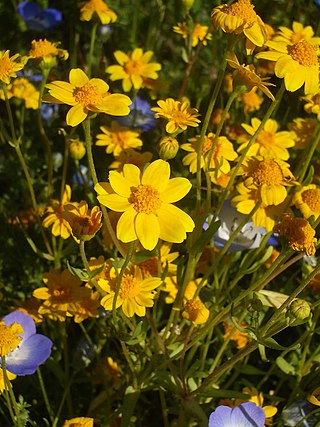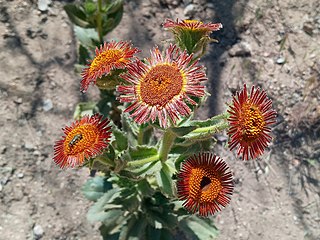Description
Lasthenia coronaria is an annual herb approaching a maximum height near 40 centimeters. The stem may be branched or not and it bears linear or deeply divided, pointed leaves up to about 6 centimeters long. The leaves, and sometimes the stems, have a coat of glandular hairs. The foliage has a sweet scent.
Atop the stems are inflorescences of flower heads with hairy, glandular phyllaries. The head contains many yellow disc florets with a fringe of small yellow ray florets.
The fruit is a hairy achene up to about 2 millimeters long.

Lasthenia, commonly known as goldfields, is a genus of flowering plants family Asteraceae. The genus is named after Lasthenia of Mantinea, a cross-dressing female pupil of the ancient Greek philosopher Plato.

Lasthenia burkei is a rare species of flowering plant in the family Asteraceae known by the common names Burke's goldfields and Burke's baeria.

Hulsea heterochroma, commonly known as redray alpinegold, is a species of flowering plant in the family Asteraceae.

Lasthenia californica is a species of flowering plant in the family Asteraceae known by the common name California goldfields. It is native to western North America.
Lasthenia chrysantha is a species of flowering plant in the family Asteraceae known by the common name alkalisink goldfields. It is endemic to the California Central Valley, where it grows in vernal pools and alkali flats.

Lasthenia ferrisiae is a species of flowering plant in the family Asteraceae known by the common name Ferris' goldfields. It is endemic to the California Central Valley, where it grows in vernal pools and alkali flats.

Lasthenia fremontii is a species of flowering plant in the family Asteraceae known by the common name Frémont's goldfields. It is endemic to the California Central Valley, where it grows in vernal pools and meadows.
Lasthenia glaberrima is a species of flowering plant in the family Asteraceae known by the common names smooth goldfields and rayless goldfields. It is native to western North America from British Columbia to California, where it grows in wet meadows and vernal pools.
Lasthenia microglossa is a species of flowering plant in the family Asteraceae known by the common name smallray goldfields. It is endemic to California, where it grows in shady areas in a number of habitats.
Lasthenia minor is a species of flowering plant in the family Asteraceae known by the common name coastal goldfields. It is endemic to California, where it is a resident of coastal and inland grassland habitat.

Arnica nevadensis is a North American species of arnica in the sunflower family, known by the common names Nevada arnica and Sierra arnica. It is native to the coniferous forests of the western United States, primarily the Cascades and Sierra Nevada.
Arnica spathulata is a rare North American species of flowering plant in the family Asteraceae, known by the common name Klamath arnica. It is native to the Klamath Mountains of northwestern California and southwestern Oregon. It grows in woodland habitat, almost exclusively on serpentine soils.
Arnica viscosa is an uncommon North American species of flowering plant in the family Asteraceae, known by the common name Mount Shasta arnica.
Erigeron multiceps is a species of flowering plant in the family Asteraceae known by the common names Kern River daisy and Kern River fleabane. It is endemic to California, where it is known mostly from the Kern Plateau in the southern High Sierra Nevada of eastern Tulare County. It is a perennial herb growing a hairy stem up to about 20 centimeters tall from a taproot and caudex. The base of the stem is surrounded by oblong leaves 2 to 5 centimeters long, and there are some smaller leaves along the length of the stem. The inflorescence produces hairy, glandular flower heads filled with yellow disc florets and a fringe of up to 125 thin, flat white to purple-tinged ray florets. The fruit is an achene with a pappus of bristles.

Hieracium argutum is a species of flowering plant in the family Asteraceae known by the common name southern hawkweed.
Lasthenia platycarpha is a species of flowering plant in the family Asteraceae known by the common name alkali goldfields. It is endemic to California, where it is known mainly from the Central Valley.
Lessingia tenuis is a species of flowering plant in the family Asteraceae known by the common name spring lessingia. It is endemic to California, where it is known from the San Francisco Bay Area to Ventura County. It grows on the slopes of the California Coast Ranges in common local habitat such as chaparral.

Laphamia inyoensis, known by the common names Inyo rockdaisy and Inyo laphamia, is a rare species of flowering plant in the aster family.

Arnica dealbata is a species of Californian plants in the tarweed tribe within the aster family

Agnorhiza ovata is a species of flowering plant known by the common name southern mule's ears. It is native to the mountains and foothills of southern California and Baja California, occurring the Coast Ranges and Sierra Nevada foothills in Tulare, Kern, Ventura, Los Angeles, Orange, Riverside, and San Diego counties in California, with additional populations in the Peninsular Ranges south of the international border.
This page is based on this
Wikipedia article Text is available under the
CC BY-SA 4.0 license; additional terms may apply.
Images, videos and audio are available under their respective licenses.











